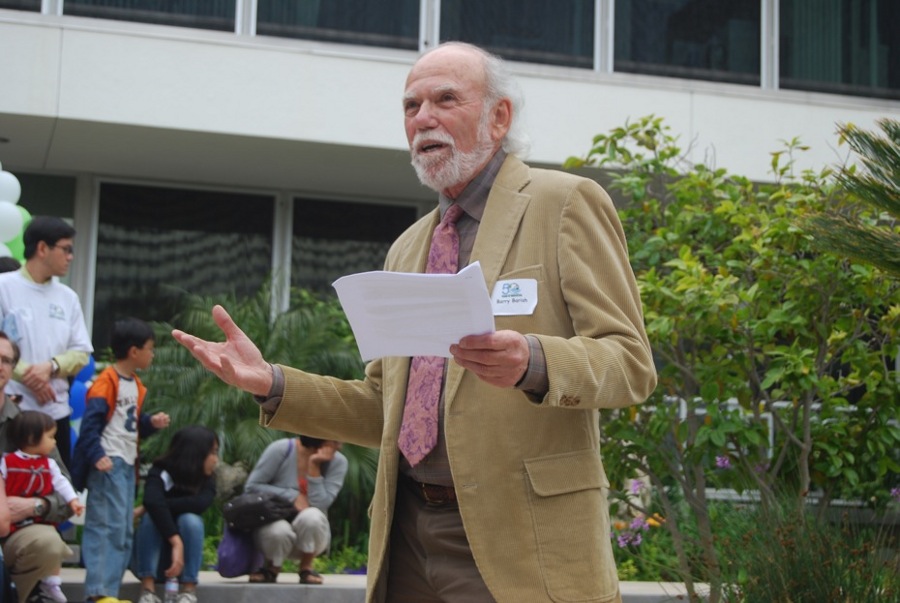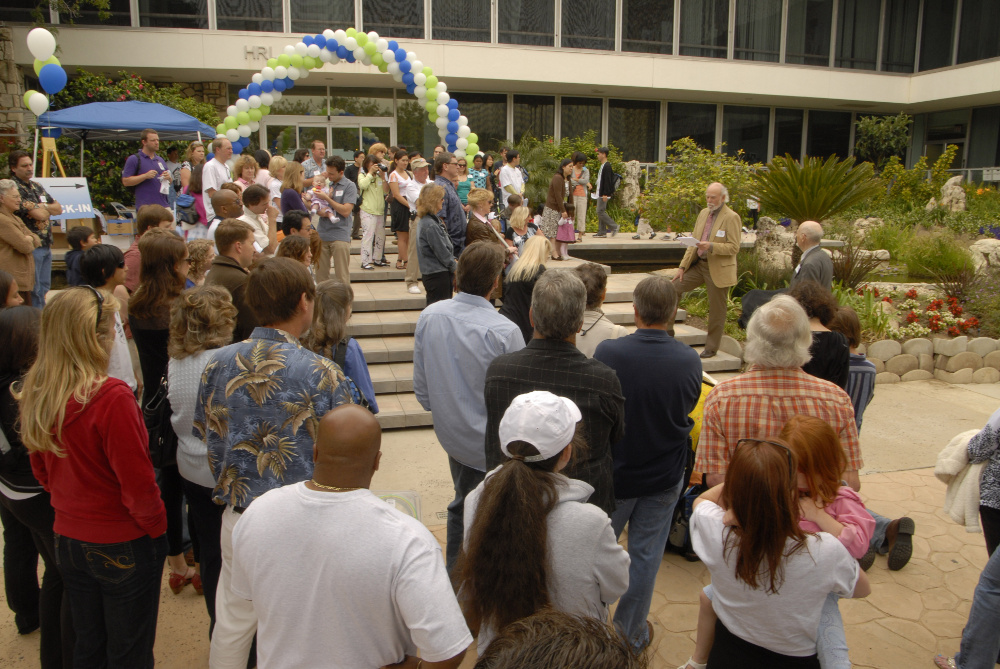Director's Corner
1 July 2010
 Barry Barish |
Celebrating the fiftieth anniversary of the laser
This year we are celebrating the 50th anniversary of Theodore Maiman's demonstration of the first working laser at Hughes Research Laboratory in 1960. The laser has become so common that what began as an acronym describing a physics phenomenon (LASER for Light Amplification by Stimulated Emission of Radiation) is now commonly understood noun worldwide. In the English language, it is defined in the Compact Oxford English dictionary as: "laser: a device that generates an intense narrow beam of light by stimulating the emission of photons from excited atoms or molecules." The development of the laser from a fundamental physics discovery to a multibillion-dollar industry and its pervasive and unforeseen impacts on how we live, make a very powerful case for the value of basic research.
 Theodore Maiman with the first working laser at Hughes Research Laboratory in 1960 Photo Credit: HRL Laboratories, LLC, from laserfest.org website Theodore Maiman with the first working laser at Hughes Research Laboratory in 1960 Photo Credit: HRL Laboratories, LLC, from laserfest.org website |
The story of the laser began in 1917, when Einstein predicted a new phenomenon that he called stimulated emission, where a photon interacts with an electron in an excited molecule or atom, causing the emission of a second photon having exactly the same frequency, direction, phases and polarisation. If the second photon is reflected such that it passes the same atoms again and again, a cascade effect can happen creating a strong directional burst of photons.
The first observed phenomena resulting from stimulated emission came decades later when Nikolay Basov and Alexander Prokhorov from Lebedev Institute of Physics described the principles of the maser, which is the precursor to the laser, and independently, Charles H. Townes and collaborators built the first maser at Columbia University, producing amplification of microwaves. In 1958, Townes and Arthur L. Schawlow describe the principle of the optical maser, or laser, which began a race which Theodore H. Maiman won by demonstrating a ruby laser in 1960. Townes, Basov, and Prokhorov were awarded the Nobel Prize in Physics in 1964.
Maiman's demonstration of laser light was described recently by Tom Baer, Stanford Photonics Research Center, on the back page in APS News: “On May 16, 1960, working at Hughes Research Laboratories in Malibu, California, Theodore Maiman and his co-workers C. K. Asawa and I. J. D'Haenens switched on a makeshift device that they had assembled, and hoped for the best. The device was revolutionary, yet deceptively simple and elegant-its essence was a powerful coiled flash lamp surrounding a synthetic, single-crystal ruby rod. The brilliant pulsed lamp excited chromium ions in the ruby, which then emitted a bright fluorescent pulse of red light. But the experimenters looked more closely and saw what they were hoping for, something much more unusual: a telltale burst of coherent radiation superimposed on the normal fluorescence. This team had just created the first working example of a laser.”
The economic and social impacts of the laser, following that demonstration in a physics laboratory, have been nothing short of astounding. The applications of lasers are so pervasive in our everyday lives that it is impossible to summarise them in a few sentences. When we checkout of the supermarket, our bill is efficiently tallied using a laser read bar code. When we go home, we listen to music or watch a movie using CD, DVD or now Blue Ray laser technology. When we go to work we use a small laser pointer to make a presentation and a laser printer for a hardcopy. When we want to communicate, the advances in telecommunications based on laser driven fiber optics have revolutionised the broadband era. If we need medical services, we might have the benefit of micro-machined components, new medical diagnostic instruments or maybe even laser surgery to correct our eyesight.
As scientists, lasers also pervade our work and enable many research projects not possible otherwise. I have spent the past 15 years on an ambitious search for another of Einstein's predictions, the existence of gravitational waves. Now, we believe we are on the threshold of making the first observations in the Laser Interferometer Gravitational-wave Observatory (LIGO) that are only possible because of the development of a very special laser. Similarly for the ILC, lasers are fundamental to creating the intense initial electron source that is the first element in our challenging advanced accelerator.
I recently participated in a celebration at Hughes Research Laboratory (HRL) honouring the Maiman's first working laser. Having been elected two years ago to the "Presidential-line" of the American Physical Society (APS), I served last year as APS Vice President, this year as APS President-elect, next year I will be President, and the following year past-President. There are many duties and responsibilities that come with these offices, but one of the most enjoyable so far for me was representing the APS in awarding a plaque naming Hughes Research Laboratory as an APS Historic Site.
In 2005, APS began its historic sites initiative, to recognise sites in North America of great importance to the history of physics. A distinguished committee selects the sites, and a suitable plaque presentation ceremony is arranged. Prior to HRL, 17 sites have been selected including those recognising the achievements of Benjamin Franklin, Joseph Henry, J.W. Gibbs, Michelson and Morley, Rutherford and Soddy, Arthur Compton, Robert Millikan, and Carl Anderson (at my own institution), as well as the invention of the transistor, and the Bardeen, Cooper, and Schrieffer (BCS) theory of superconductivity.
None of what I have described was foreseen when the laser was demonstrated for the first time by Maiman in 1960! The development was done as a research project to understand nature through fundamental physics research. Those of us who do expensive research project in fundamental physics are often asked to justify our research by its applications. We often don't know how what we learn might be used. There is a lesson in the story I have told of the development of the laser and the resulting multibillion-dollar industry. Transformative developments that result from fundamental scientific breakthroughs are often totally unanticipated. The development of the laser, which we are celebrating this year with the Laserfest activities, is really a celebration of the value of fundamental science.
-- Barry Barish

